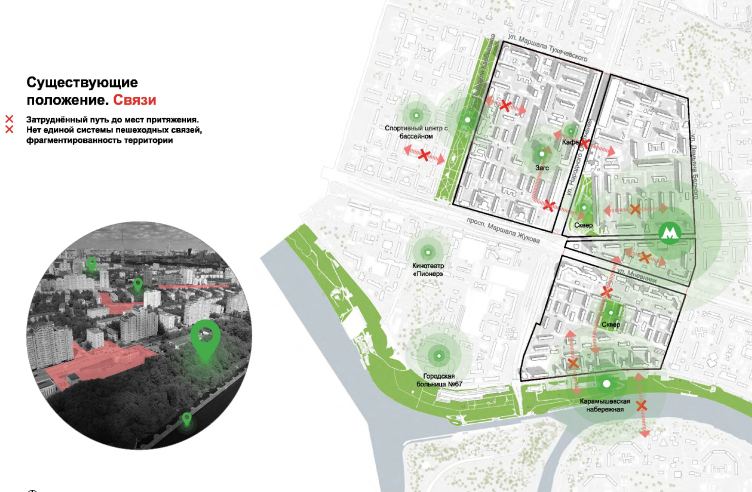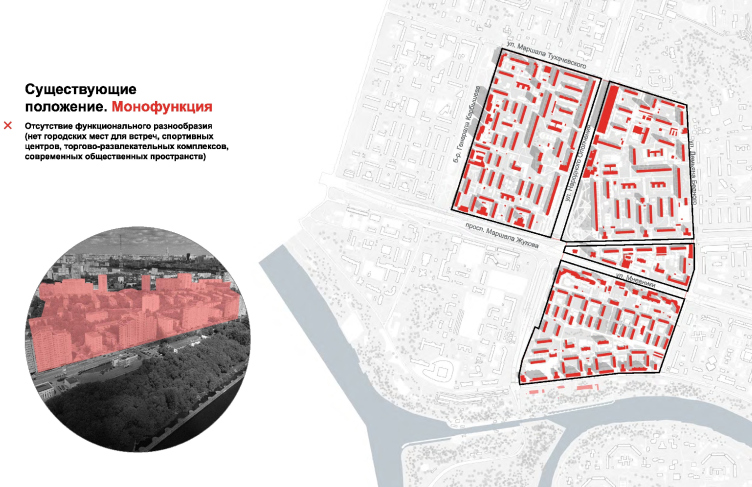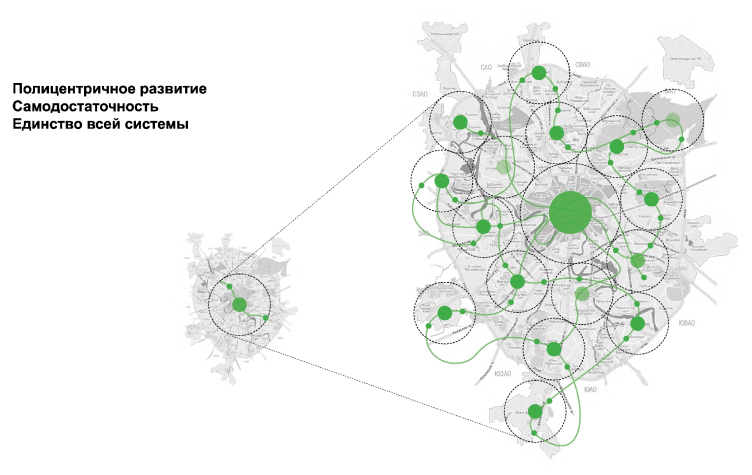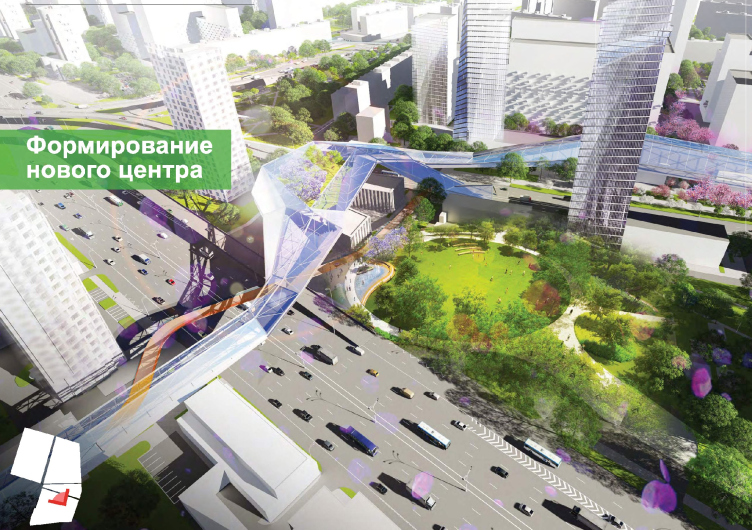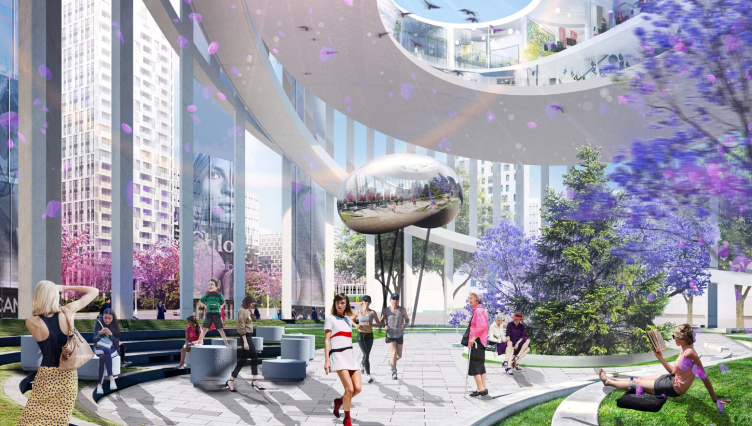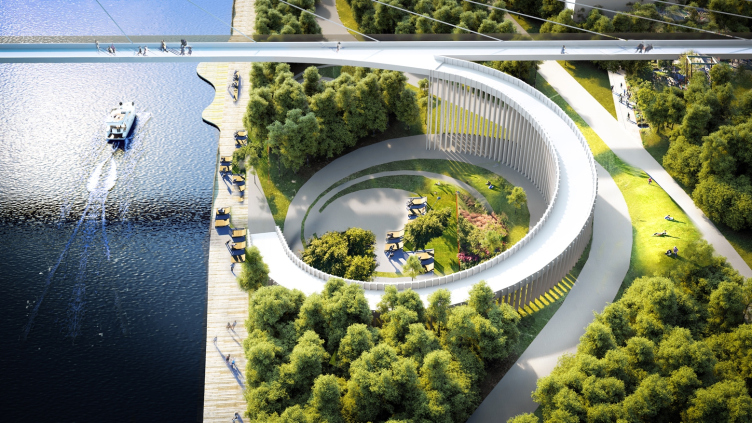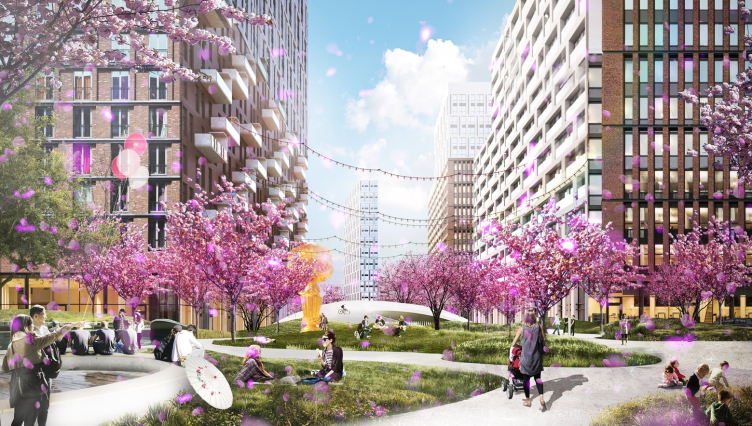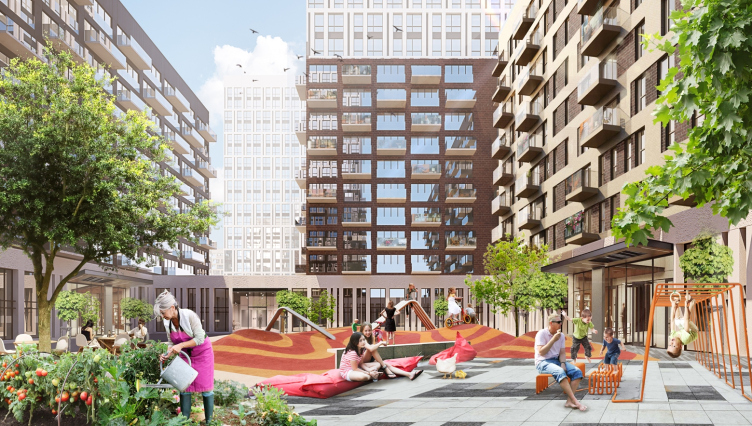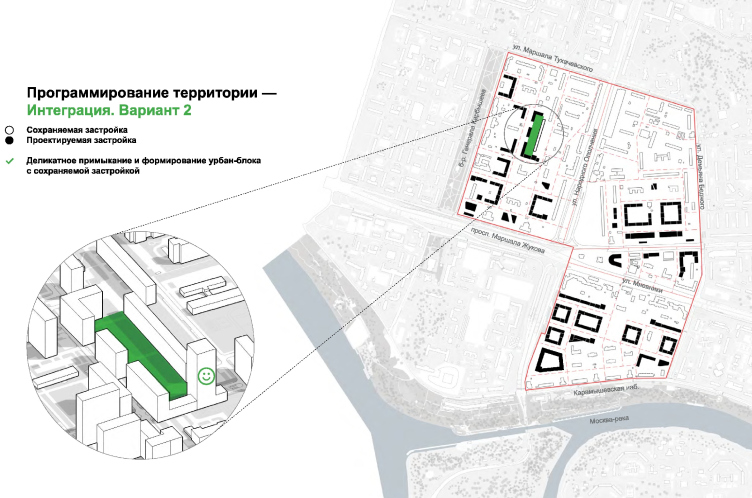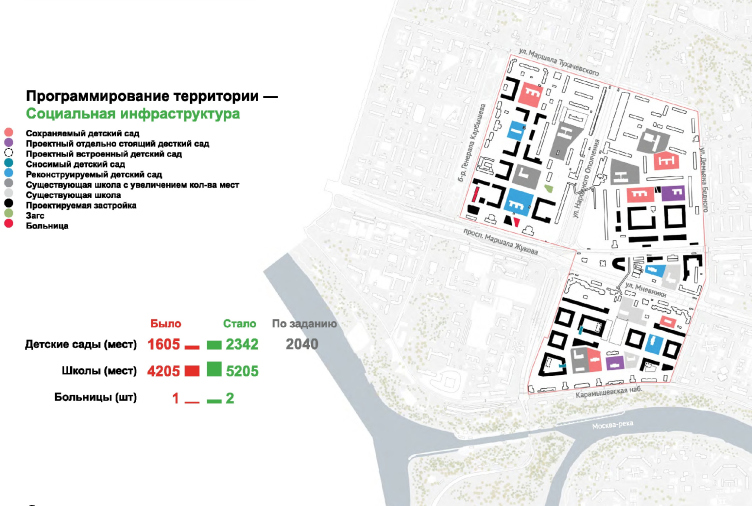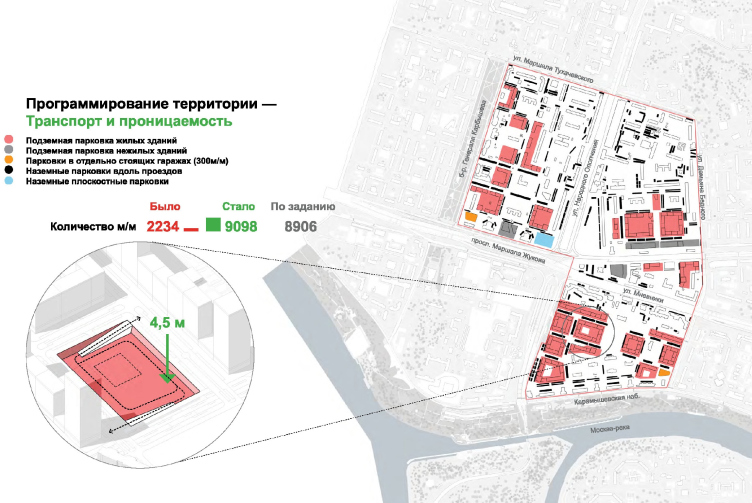What should a modern city look like? This question is as relevant as ever for the largest Russian cities. Today’s commercial housing has fallen short of becoming an adequate substitute to the critically outdated format of Soviet-style “micro-districts”. The successful experiments on developing planning solutions for large-scale multifunctional complexes, including those that are built in place of former industrial parks, such as ZILART and “Simvol” projects, have proven the necessity of total revision of approaches to designing the structure and format of the city environment. Modern cities are in need of integrated solutions that not only meet the requirements of today but also provide for the future perspective planning. The search for these solutions became the subject of a few high-profile architectural competitions. This year, Russia’s first young architecture biennale showcased young architects presenting their own vision of what comfortable urban environment should look like. Now it’s time when the giants come in – the competition for the best town-planning concepts of renovating Moscow’s proverbial five-story housing stock has attracted the attention of Russia’s and the world’s leading architectural firms. The competition for renovating city blocks of “five-stories” can be considered as a “creative” one all but conditionally. The contestants had to deal with massive data packages, functional zoning, construction rules, and land-use planning, including the task of tying the latter in with economic factors and the expected wave migration schedule. The contest was supposed to result in land use and development rules for the starting areas of the renovation program, on the basis of which the so-called “City Development Plans for Land” would be developed, which, in turn, would become the basis for designing individual buildings and projects by different architectural firms.
The contest got an extremely detailed specifications list that determined the chief parameters and principles of design and construction. The elaborate specifications for the expected solutions automatically conditioned the large degree of similarity of the end results to be submitted by different firms. The room for variability and the author’s vision was only left in a few certain areas of the project, such as: placement of compositional accents by virtue of increasing the number of floors or inclusion of original public projects; building ties with neighboring existing projects, and adding some certain “bonuses” to the program in order to give it more individuality.
The projects submitted for the competition are extremely interesting thanks to the subtle details and accents that the authors chiefly placed their bets on, as well as the set of original solutions that each team was able to insert into the rigorously regulated structure of the contest specifications.
One of the vivid examples of symbiosis between regulations and creativity, or math and emotion, can be demonstrated by the project submitted by a consortium led by UNK project. To delve deeper into its details, we asked the chief architect of the firm, Julius Borisov, to comment on the project and the competition itself.
Fragment of the new "green axis" that connects the main attraction points into a single communication system © UNK project

Yuliy Borisov, cofounder and chief architect of UNK Project:
“There are creative competitions in which you need a flight of fancy, and there are competitions that are more about the technical results. And I think that, in this particular instance, this is the latter type of competition. A concrete task was set which to a large extent determined the end result and which did not expect any groundbreaking discoveries. But it was very interesting to check out which methods and techniques would prevail, and how our eternal “swing” would work. Where is our place in the world order? We have one of our feet set in Europe, and the other in Asia. And this competition has clearly demonstrated that we are not quite Europe, and definitely not Asia. This manifested itself particularly vividly in the set figures of the construction height. It is higher than in Old Mother Europe but it is significantly lower than in today’s Asian megalopolises.
The same thing happened with the second key aspect of the program. There is a popular opinion that, architecturally, Moscow is still in fact a village. Because we have a tradition of placing our houses amidst little gardens, this village-type kind of construction. Saint Petersburg, however, is already Europe because in that city the houses from the very start were placed in a European pattern, along the red lines, and all. And this balance between the village “estate” construction and the regular European pattern is also to be traced in the submitted project proposals”.
***
Territory
The consortium consisting of Russia’s UNK project, Japan’s Nikkei Sekkei Ltd., as well as Drees&Sommer and Sinergy project, has come up with a project proposal for the district of Khoroshevo-Mnevniki. This is an actively developing city area that already has on its territory some examples of new construction taking the place of the old five-story houses. New houses are actively built here, which in itself speaks for the popularity of this part of the city, again, unsurprisingly. It has a highly developed social infrastructure, a large green zone running along the Karamyshevskaya Embankment, and a sufficient public transportation system. The local residents still lack the parking space, recreational infrastructure, and additional pedestrian ties with surrounding attraction points. In addition, the public function is practically nonexistent, and there are virtually no workplaces in the district itself. There are connectivity issues between District 77, which has a shape of a triangular wedge formed by the Mnevniki and Demyana Bednogo streets, and the in-block driveway, which, like a barrier, separates the north part of the district from its south part that borders on the recreational waterfront.
Existing situation. Connections © UNK project
Existing situation. Mono-function © UNK project
Conceptual approach. “Mini-Moscow”
One of the characteristics stipulated by the contest specifications – the next most important one after the city-block system – was the multifunctional quality of the designed project. This principle – one of creating workplaces in the peripheral areas of the city with a view of cutting down on the transportation system workload – is currently applied virtually in every project of integrated multifunctional housing. In addition to the public ground floors, the competition also welcomed the creation of public centers that would perform the business, shopping, and cultural functions. All the contestants took this rule into consideration. Some did this to a larger, and some to a smaller degree, in some projects the public and business functions help to solve compositional and planning tasks, and some architects find for them a more conceptual or literary rationale.
Yuliy Borisov:
“Our project is based on the following principle: we believe that Moscow has evolutionarily formed a unique structure of its own or a canonic plan, a space DNA of its kind, in which the main public center – the Red Square – forms around itself other different functional zones – the “Moscow City”, and the recreational zones of parks and residential blocks. And we believe that this is the most natural and the most effective system for developing this city – to use the same structure, the same DNA, although on a smaller scale, in its peripheral areas. This is both mathematical and biological approach at the same time. We repeat this plan in our district by creating in it a center, a nature zone, its “city” (i.e. the business area), and so on. We tried to build, within a walking distance from the Khoroshevskaya metro station, such “mini-Moscows” of clusters that are comparatively small yet filled with very diverse functions.
The similarity principle that repeats on a smaller scale the compositional and functional arrangement characteristic fort the entire Moscow © UNK project
Mini-City
The community center is situated within the triangle next to the metro station that used to split the territory in two – in its new capacity it is capable of the becoming the exact opposite of what it used to be, a pivot that joins the birth and the south area, and a point where the communication channels come together. This community center, the nucleus of the new “Mini-Moscow” will include a transportation hub, a business center consisting of several towers (whose joint podium and bottom floors will be occupied by the business center itself, while the upper floors will be residential ones), as well as an education center with sports facilities.
Forming the communication system © UNK project
One of the new communication channels crosses the northern part and leads, through a system of pedestrian promenades, in the direction of the Serebryany Bor Park. Still another, also leading from one green zone to another, stretches southward, towards the Karamyshevskaya Embankment and further away across the Moskva River, over which, according to the authors, a hanging bridge should be built here that will connect the district of Mnevniki to the district of Fili.
Creation of a "green street" - a roofed pedestrian bridge with a service and retail functions © UNK project
Part of the L-shaped axis is designed as a pedestrian bridge with a developed commercial function. This pedestrian promenade connects two parts of the district, providing the local residents with an opportunity to make part of their way from home to the metro station in comfort thanks to the numerous shops and cafes.
The area withon 500 meters fropm the metro station will become the territory's main public center © UNK project
System of Squares
Along the communication L-shaped axis, the architects have built a system of a few public territories – squares, boulevards, and recreation and communication zones, for which the authors of the project came up with their own unique functions. Such differentiation will help the local residents to use their specifics in accordance with their preferences, hobbies, and pastimes, avoiding concentrating in one and only recreational zone. The system of city squares consists of “Family Square”, “Sakura Square” with a decorative garden, an all-year central square for the city events, “Green Square” – a space for games and active recreation, and a “Square on the Water”, connected to a landscaped waterfront and the recreation area stretching along the Moskva River.
The central square, the all-season venue for city events © UNK project
"Green Square" - the place for games and active recreation © UNK project
"Square on the water" is connected with an improved embankment and a recreation zone running along the Moskva River's waterfront © UNK project
Gardens in Bloom
The renovated areas of “five-stories” are chiefly loved by their residents for the large amounts of greenery. Over the time that has elapsed since the middle of the last century, their yards have hosted trees that were planted by the original residents of these buildings. For the residents of these neighborhoods, the abundance of greenery is a necessity and an important element of the city environment. Quite a different matter is the fact that most of the greenery in the yards is not properly cared for in any way. Without proper maintenance, these little parks turn into derelict territories with grassless land и stunted vegetation. The residents want to keep the greenery but it must be fundamentally different. The designers proposed to curtail the square footage of the green zones but improve, at the expense of extra financing, their landscaping quality, turning them into veritable landmarks of the area.
One of the new squares - the "Sakura Square" with a decorative garden © UNK project
Yuliy Borisov:
“For us, it was extremely important to fill the project with emotion. Town planning is an exact science, but, as creative people, we decided to spice up this math with poetry and emotion. Together with our Japanese partners, we decided to use gardens and different blossoming trees that would give our blocks more individuality at the expense of odor and color. Those who live in the vicinity of Moscow State University know how differently fruit trees may blossom: apple trees, cherry trees, pear trees, and so on. By planting gardens of different trees, we program the identity of each block or even each house. It will be just great if the future residents are able to say “I live in a cherry garden” or “I live in an apple garden”.
Family Square
According to the rules of the renovation program, not all the old buildings situated within the reconstruction zone are subject to demolition. How to handle the other buildings is a separate issue solving which also gave the architects room for showing their creative vision. And in some cases these “problem” buildings generated bright and unconventional ideas for developing this project. In this particular instance, for example, in the northwest part of the area, the bottom floors of two nine-story high-rises host the local Registry of Births, Marriages, and Deaths. Instead of getting a quiet yard, the residents of these two towers live in a state of constant chaos: the noisy cars of the newlyweds come and go parking pretty much the way they choose to. Removing the Registry Office is out of the question, and, come right down to it, for many of the local residents it has become a “heritage site” of its kind because many of them got married here. Solving the problem was made possible by using town-planning techniques.
"Family Square" the architects' gift to the local residents as a token of respect to their traditions © UNK project
Yuliy Borisov:
“What we ultimately decided to do was, instead of breaking the historically formed tradition, to improve the situation around the registry office. We enlarged the area, organized a special driving access and parking system for the wedding cortège so that they would not disturb the local residents as much. And then we also added a restaurant so that all the newlyweds could have a wedding party here and now if they choose to”.
Housing
The housing project was developed on the basis of the “city-block” principle stipulated in the specifications. In some cases it presupposed closed-type blocks, and in some cases – open-type ones. The team paid specific attention to preparing not one but several versions of the project for integrating the preserved buildings with the city-block planning system in order to provide a single system of dividing the area into public and private territories, using, wherever possible, the old buildings for forming new urban blocks, as well as creating a denser town-planning structure.
Inner yard of the city block - a private territory for the residents of the surrounding buildings © UNK project
Yuliy Borisov:
“We placed our bets on the diversity of housing typology. If a person wants to lead a good life in Mnevniki, he can live either in the preserved 9-story houses or in the towers: nearby, there are both soviet-time and modern commercial residential complexes, or in our new city blocks. They all are distributed in approximately equal shares, and this is what makes this situation so harmonious. People will have a choice of where and how they want to live, and choice is a wonderful thing. I am absolutely sure that this renovation program is not ball and chain at all. A person can get one apartment, then change it for another one. It’s important that there should be a choice of housing typology”.
One of the options for integrating the new construction with the preserved houses © UNK project
The planning and architectural solutions of city-block construction are maximally effective and laconic. The buildings will get a more detailed treatment during the next stages of renovation program, most likely, with the input from other design companies. The contest project provides for the sequence in which the old buildings will be taken down and new ones will be built on the territory of the district.
Yuliy Borisov:
“One of our main tasks is to optimize the renovation schedule and the plan for populating the new housing stock. According to our basic estimates, it turned out that it would take as much as two decades to complete the construction of all the new buildings and bring in all the residents of the five-stories to be demolished. Just imagine that over these 20 years a whole generation of children will grow that will live amidst the construction site, surrounded by construction pits and engineering lines... This is extremely inconvenient and uncomfortable. We tried to organize our project proposal in such a way that each block is independent and self-sufficient, allowing us to make changes to the project after implementation of every separate stage depending on the economic situation. This ensures the sustainability of the project”.
New quality of environment
The contest for renovation concepts had a purpose of finding new methods and formats for creating a comfortable and aesthetically appealing urban environment, and defining what a city may be like in order to become a great place to live in. But here it is not about the ideal fantasy cities the way they are depicted in utopian movies and novels. It’s all much more practical and down-to-earth. And this is rather a plus of this program than its minus. People will live in multi-apartment buildings, cars will drive down the streets, parks will be full of parents going for walks with their children. The set of constituent elements will remain the same, and even their outward appearance will remain pretty much the same at least within the next fifty years. So, what factors can and should condition the change in the city environment? What will come to replace the infamous “sleeping-belt” neighborhoods, and why? The answers to these questions are to be found in every contest project.
Yuliy Borisov:
“The quality of the urban environment keeps on improving in the new projects, first of all, at the expense of the right organization of space. At a first glance, one might think that there is nothing new about these projects at all – the same buildings, parks, and squares. Yes, the set of constructive elements remains the same. What changes is the ratio of these spaces and the interrelation between them. In those “micro-districts” everything was everybody’s. Anybody could walk around wherever he pleased. Any bum could sit drinking on a children’s playground. Drivers would park their cars wherever they could. The local residents were not cool with that, and what they did about that was build all kinds of fences and railings. Uncared for, these green yards were consumed by slow decay. And it seemed that it was going alright while it actually wasn’t. We basically use the same techniques, the same “little bricks”, only we place them in a different order, the kind that we believe answers the requirements of the people’s life that has considerably changed. This clear-cut division into public and private spaces will make the yards safer; thanks to the underground parking garages, the cars will vanish from the pedestrian passageways, and the parks will grow smaller but they will be better looked after, and their quality will improve. We change the space, using simple and comprehensible (economy-wise) ways and means, keeping in mind, at the same time, that this renovation program is financed by the city budget, i.e. our own money”.
With the growing population in mind, new schools and kindergartens are designed. What is remarkable is the fact that, according to the project schedule, the social infrastructure projects are built ahead of residential houses © UNK project
Organization of underground parking garages and vehicle-free yards © UNK project




